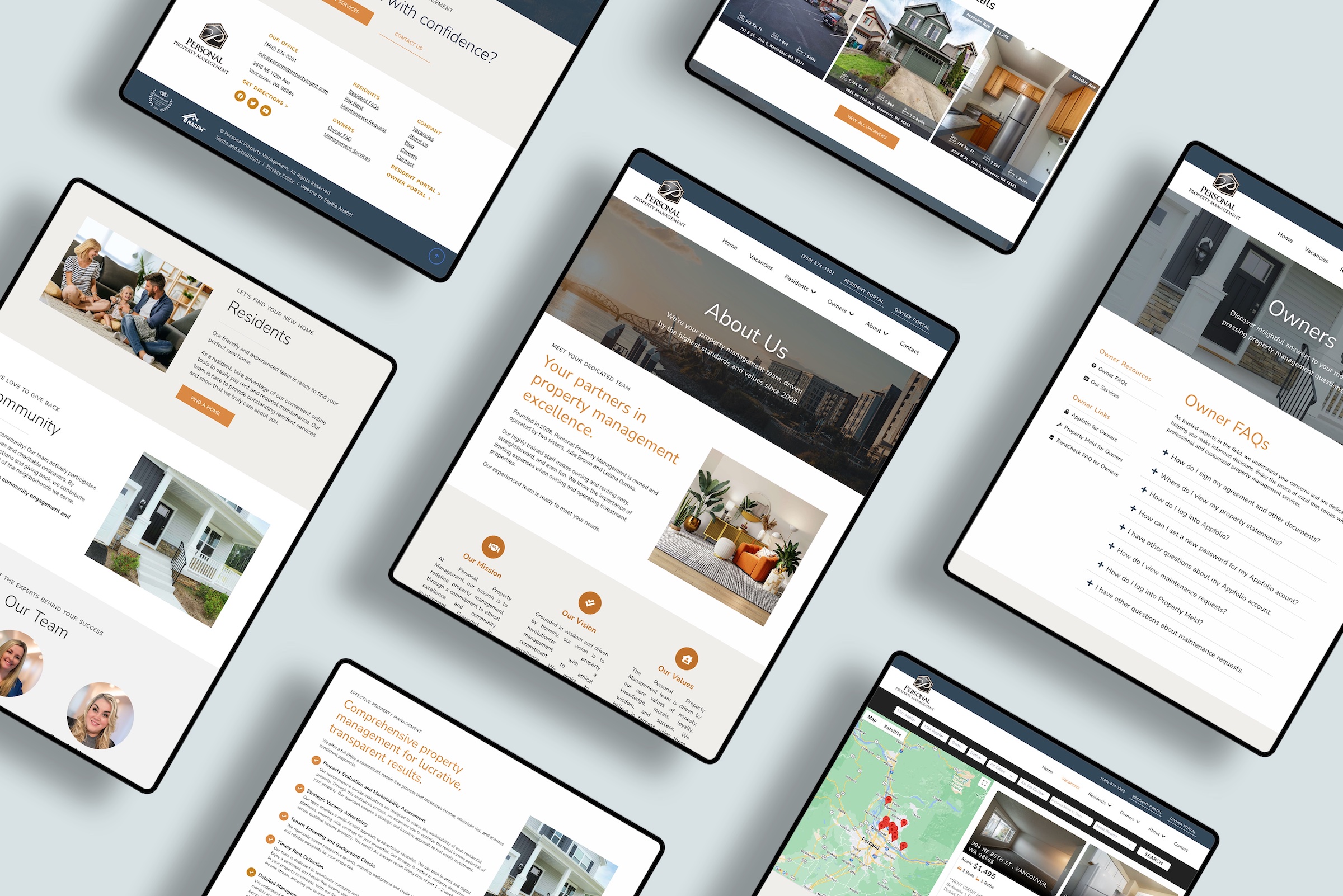For any property management company, a strong online presence is essential to attract new tenants and property owners.
Besides serving as the digital storefront for your company, your website also acts as the primary point of contact for potential clients, tenants, and owners. It must showcase available properties, communicate your company’s value, and make it easy for tenants and owners to find the information they need.
Just having a website doesn’t mean having a good website. Many property management companies find themselves with websites that are boring, confusing, and even broken.
That’s when it’s time for a website redesign.
How do you when it’s time to redesign your property management website?
There are a few key signs that it’s time to redesign your property management website.
Fix broken features and outdated styles by redesigning your website.
Your website may have an outdated design that makes it hard for visitors to navigate through the pages. Glitches and broken links may make it impossible for tenants to pay their rent online or request maintenance.
Add missing functionality with a website redesign.
Your website may be working, but incomplete. Missing important integrations such as Appfolio, Tenant Turner, or Rently means you’re left to deal with repetitive calls to your office, demands from tenants and owners, and higher admin demands on your team.
Include company growth through a website redesign.
On the other hand, you may have added new tenant resources, updated your application process, or widened your service area. These updates and evolving industry standards can necessitate a website redesign to keep your website modern, competitive, and aligned with industry best practices.
The good news is that a website redesign can address all of these problems — if the redesign is handled in the correct way.
A great website redesign presents an opportunity to update your design, incorporate new features, and add functionality.
Your property management website can evolve from an outdated design into a sleek, modern powerhouse that attracts new property owners, engages your tenants, and propels your business growth.
2024 Case Study
Website Redesign for Personal Property Management in Vancouver WA
Discover how Studio Anansi redesigned the Personal Property Management website to communicate their company values, attract new tenants, and retain property owners.
Which features are important when redesigning property management websites?
Several essential features should be on all property management websites. These are crucial no matter where you operate or which platform you use to manage properties.
Property listings to help tenants find vacancies.
Your website should include a listing of available properties with information about the property, application requirements, and photos. In an ideal world, your website should also include a map of properties, plus links to book a tour or apply online.
Search filters to make it easier to use your site.
Your different prospective tenants will have different needs. To enhance user experience and make it easier to use your website, your website should provide search filters that allow visitors to refine their searches. Search criteria can include location, price range, amenities, and property type.
Online rental applications to streamline the application process.
When tenants can submit their rental applications electronically, it streamlines the leasing process and grows your business with less repetitive back-and-forth communication. Your website can reduce overhead by making it simple for prospective tenants to apply online.
Tenant portals to help you collect rent and save time.
It’s important to provide a secure, easy way for tenants to access their documents, pay rent online, and submit maintenance requests. Make it clear on your website where tenants can find this information, and be sure to tell prospective tenants about this benefit, too.
Owner portals to make you stand out for property owners.
Owners also need a dedicated space to view financial statements, track their property information, and communicate with your team. In today’s competitive market, your property management company can stand out by making it easy for owners to access this information online.
A maintenance request system to keep communication organized.
We all know that properties need maintenance, and emergencies inevitably arise. Your website can keep things organized and streamlined with a straightforward link for tenants to report maintenance issues and put in service requests.
These features are important for all property management websites — but they’re not the only features that matter.
Important modern website features for your redesigned property management site.
The difference between a good website redesign and a great website design is in the details. To get the most out of your website investment, be sure that your redesign includes these crucial elements.
SEO (search engine optimization) to help attract new tenants and owners.
Optimizing your website for search engines ensures that it ranks well in search results, driving organic traffic to your site. Your website designer should incorporate relevant property management keywords, meta tags, and structured data to attract more visitors through search.
Responsive design to make it easy for people to use your website on phones.
With the increasing use of mobile devices, your website must be optimized for all screen sizes. Be sure that your web design creates a responsive design that adapts to different devices and provides a user-friendly experience for all tenants and owners — whether they’re on their phones or computers.
Legal policies to protect your property management company.
Legal policies protect your business and establish trust in tenants and owners visiting your website. You or your designer should ensure that your website complies legally by including essential policies such as terms of service, a privacy policy, and cookie consent information.
Accessibility standards to keep you compliant.
Make your website accessible to all users by following web accessibility standards such as the Web Content Accessibility Guidelines (WCAG). Your website designer should know ways to improve accessibility, including adding alt text to images, using clear fonts, and testing color contrasts.
These features and more are included in each Studio Anansi website design. Learn more about our web design services and view our current Services & Pricing Guide for more information.
What are the best steps to redesign a property management website?
Redesigning your property management website involves many stages. Your website designer will walk you through each step, including content planning, market research, page design, and launch.
Each step is important to ensure that your redesigned website meets the needs of your tenants and property owners — and drives your business growth forward.
Step 1: Assess your current property management website (or your competitors).
Before starting a new website design, it’s important to know what is (and is not) working with your current website. Your website designer will help evaluate what you like about your current site, what issues you’re having with the site, and areas to improve. If you don’t have a website, look at your competitors. What do you like about their website? What would you change and improve?
Step 2: Define your website redesign goals.
Websites have different goals, and understanding your specific goals is crucial for creating an effective new website. Are you trying to attract new tenants? Do you need an easy way for owners to contact your team? Your website designer should dig into your business objectives and make sure that the redesign will help you accomplish those goals.
Step 3: Research the market and your competition.
Your property management company likely has regional competitors. As your designer researches competitor websites, they will be able to identify strengths, weaknesses, and areas for differentiation. This research also uncovers industry trends and best practices, so your designer can be sure that your property management website stands out online.
Step 4: Design and test your new website.
It’s time to design! Every designer has a different process — but at this stage, it’s safe to assume that your designer will be building and testing new website pages. At Studio Anansi, we design your new homepage and one webpage to demonstrate new design components. Once we gather your feedback, we build out the remaining pages.
Step 5: Launch your new property management website.
After you’ve finished the last round of design updates, it’s time to launch your new property management website. A successful launch is the final step in revealing your new website to the world — and it has to be handled with care.
How to successfully launch a redesigned property management website.
Launching a new property management website is a delicate operation. If a launch goes wrong, your tenants and prospective clients will be left with a confusing error page and missing information. To be sure your launch goes smoothly, our website launches follow these steps.
Start by planning the website launch and expected downtime.
When a website launches, it can take up to 72 hours for new content to be available online. In order to minimize downtime for your tenants and property owners, it’s best to pick a period of low website traffic — overnight on a weekday, for example.
Next, monitor the website performance post-launch and address any issues.
After launching your redesigned website, we test your pages and buttons on multiple screen sizes. This device testing lets us catch any bugs or issues that may have come up — whether that’s slow load time, missing images, or broken links. By testing immediately after the launch, we can fix any problems before they become larger issues for you down the road.
Finally, be sure to maintain and update your redesigned website for ongoing functionality.
Even after launch, we monitor your site performance and check in with you for feedback.
Many times, property managers will find new features and updates for their site after launch — whether that’s making a link more prominent, changing team information, or adding new images for prospective tenants.
No matter what kind of update you need, we’re here to support you even after the new site launch.
Ready to redesign your own property management website?
When you’re ready for a website redesign, it’s important to find a designer who understands your industry and can fulfill your needs.
At Studio Anansi, we love designing new websites for property management companies — and our clients love our communication, expertise, and effective designs.
2024 Case Study
Website Redesign for Personal Property Management in Vancouver WA
Discover how Studio Anansi redesigned the Personal Property Management website to communicate their company values, attract new tenants, and retain property owners.
Ready to start?
Get in touch to learn more and start your property management website redesign today.
Key Takeaways to Redesign a Property Management Website
1. Many property management websites need a redesign.
Issues such as broken features, outdated design, and missing links frustrate tenants and owners on your website, resulting in lost business opportunities.
2. Property management websites need essential features.
Features such as online property listings, property applications, tenant portals, and a maintenance request system make it easier for people to use your website — and they save time for your team.
3. A good redesign should include modern website elements.
Help your property management website stand out and attract new clients with SEO optimization, responsive design for mobile devices, and legal policies.
4. Effective website redesigns follow a structured process.
Your web designer should have organized steps to assess your current website, define your goals, research competitors, and test your redesigned website.
5. For your website redesign to be successful, the launch should be carefully planned.
Plan the new website launch to minimize downtime and address any post-launch issues promptly to ensure that your new website meets the needs of your tenants and owners.






